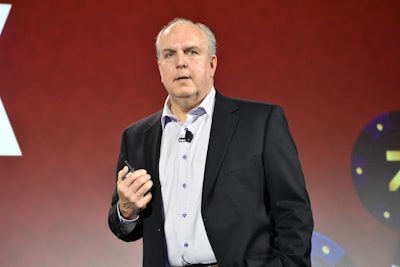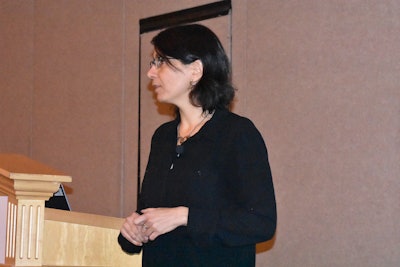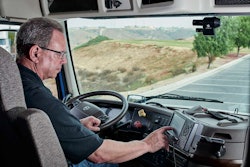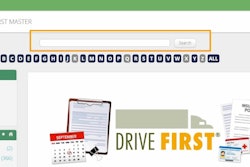 Ray Greer, CEO of Omnitracs, shared a new strategy to accelerate technology migration and innovation at the 2020 Omnitracs Outlook user conference.
Ray Greer, CEO of Omnitracs, shared a new strategy to accelerate technology migration and innovation at the 2020 Omnitracs Outlook user conference.Fleet management technology provider Omnitracs last year signed more than 1,100 new customers to grow 9% year-over-year, and shipped more than 120,000 fleet management devices across North America.
While reaching new heights in 2019, it “wasn’t all a bed of roses,” Ray Greer, chief executive officer, said Monday in Las Vegas at the 2020 Omnitracs Outlook user conference.
Greer addressed a service outage the company had in early November. Approximately 180,000 MCP devices were impacted. He learned about the outage from an ominous text message he received on Saturday evening, Nov. 2: “MCP outage. Unsure of the problem.”
Omnitracs’ legacy MCP hardware became inoperable, leaving fleets and drivers without electronic logging and other critical business applications.
The MCP devices were developed by Qualcomm before selling its Omnitracs business unit to Vista Equity Partners in November 2013.
The problem was determined to be an embedded chipset developed by Qualcomm and Sierra Wireless for the MCP devices. Those companies no longer support the chipset. “Anybody who knows anything about those chips are either dead or retired,” Greer said.
On Wednesday, Nov. 6, Omnitracs sent a firmware update to MCP units over-the-air to restore operability.
Following the incident, Omnitracs hired consulting firm Pricewaterhousecoopers (PwC) to conduct a thorough investigation. The learnings from the outage, Greer said, sparked an epiphany for the company to speed the migration of customers to its new cloud-driven technology platform.
“There is a very natural tension between supporting, maintaining and sustaining old technology and innovating with new technology. Somewhere, as an industry, we have to find a balance,” he said.
Eliminating hardware
The new strategy for Omnitracs is to leverage the telematics systems that vehicle OEMs install at the factory. Omnitracs hired a team of employees to execute and support this strategy, which will eliminate the need for customers to purchase, install and refresh mobile hardware devices.
 Mic Yariv, vice president and general manager of strategic initiatives, gave an update of new products under development at Omnitracs’ Innovation Center in Chicago.
Mic Yariv, vice president and general manager of strategic initiatives, gave an update of new products under development at Omnitracs’ Innovation Center in Chicago.Fleets have been asking Omnitracs to innovate at a faster pace, but its progress has been slowed from investing 300 man years to develop ELDs during the past few years. Greer said customers will see innovation accelerate from the company spending $70 million annually on research and development.
He compared the company’s new OEM strategy and R&D investments to a train leaving a station and the rate of acceleration increasing every mile. “At some point we will get up to full speed and begin to lengthen our stride and quicken our pace as we move through innovation.”
The sunsetting of the 3G wireless network is another reason to accelerate migration to new hardware platforms. Greer estimates that two-thirds of all Internet of Things (IoT) devices that are deployed in all industries use 3G, which the cellular networks plan to sunset at the end of 2021.
“We understand it, and it doesn’t mean it couldn’t be extended, but it’s real,” he said.
As part of the migration to 4G, last December the company delivered an enterprise grade version of its Omnitracs One platform, which is now deployed at customers with a total of 15,000 vehicles. The platform was developed by hiring software developer Red Hat, and through the March 2019 acquisition of Blue Dot, and integrating its driver workflow application with Omnitracs One.
“We are continuing to look at mergers and acquisitions that accelerate our strategy of migrating from monolithic devices to true, agile, cloud-enabled solutions,” he said.
During the keynote, Greer said Omnitracs is facilitating greater interoperability for third-party applications with open APIs, and the Omnitracs One platform is “really geared to begin changing the way we think about this industry.”
Location intelligence
Another major initiative from Omnitracs involves leveraging its large industry dataset. During a breakout session, Mic Yariv, vice president and general manager of strategic initiatives, gave an update of new products under development at the company’s Innovation Center in Chicago.
 More than 800 people attended the Omnitracs Outlook user conference in Las Vegas, Feb. 16-18
More than 800 people attended the Omnitracs Outlook user conference in Las Vegas, Feb. 16-18“We think there is a lot of ways we can help the industry by leveraging data,” she said. “If we can accurately predict the end-to-end service time of a load, we can help the industry move from mileage as a metric to time.”
Omnitracs has identified and geofenced 6.69 million shipping and receiving locations. Data scientists are aggregating dwell times to predict how much time drivers are going to spend loading or unloading. The plan is to create a website for fleet operators and a workflow application for drivers to plan their trips.
“We feel this is really important in a post-ELD world to really optimize the hours you have available for a driver,” Yariv added.
One product that is close to launch is real-time micro weather alerts. The company developed a proof-of-concept that utilizes data from road cameras, weather drones and microwave signals from cell towers, she said, to give drivers micro weather alerts for impending conditions on their routes in the next 10 to 15 minutes based on speed and heading.
The concept has a feedback loop to monitor for changes in driver behavior, and a dashboard for fleet managers to see trucks in affected weather areas and a history of high risk alerts and how drivers responded to the information, she said.












